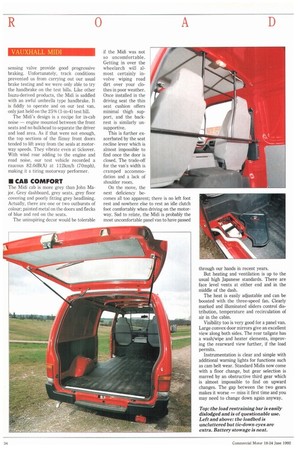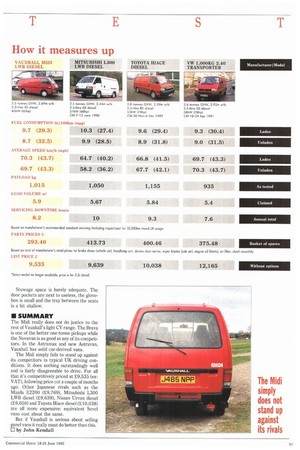T he debate is on in Luton about the future of
Page 34

Page 36

Page 37

If you've noticed an error in this article please click here to report it so we can fix it.
Vauxhall Midi production at the IBC Vehicles plant. Vauxhall is said to be considering a plan to axe UK manufacture so that production of the successful Frontera off-roader, launched last year, can be increased. Midi would then be sourced directly from Isuzu in Japan. Further space for the Frontera would be made by ending UK production of the Rascal micro van, also built at the IBC plant.
A glance at last year's SMMT figures suggests that the Vauxhall bean counters might be leaning in the right direction. Midi sales crashed 42% in 1991, a bigger drop
than the 27% average for the 1,801 —3,500kg van sector.
So how does the Isuzu designed panel van shape up in 1992? We have not tested a Midi van since the 1985 launch, barring the now-defunct 4x4. Seven years ago, it was powered by a two-litre GM diesel or 1.8litre petrol. Now, diesel power comes from a 2.2-litre IDI Isuzu engine, while the long wheelbase model partially plugs the gap left by the old Bedford CF. Standard equipment includes the front nudge bar, load restraint frame and a manual tune stereo radio/cassette player.
• PRODUCT PROFILE
Probably the greatest attraction that Japanese vans have for operators is their width, or lack of it. Their narrow bodies, designed to meet Japanese restrictions, make them particularly user-friendly for urban operations. For the LWB Midi, this results in a long, narrow load area with nearly 3.0m of usable length. Its narrowness emphasises the wheelarch intrusion, although the Midi offers marginally more space between the arches than either the Mitsubishi L300 or Toyota Hiace.
Isuzu now supplies diesel engines for many cars in Vauxhall's range and most of the light commercials. For the Midi, Isuzu's 2.2-litre IDI diesel replaced the 2.0-litre GM engine in 1988. Most rivals benefit from larger capacity diesels, so the Midi's 45kW (60hp) at 4,400rpm and 126Nm (931bft) of torque at 2,000rpm are rather modest figures by modern standards. The result is that the Midi is only a modest performer. Our listed rivals are all quicker off the mark. However, the Midi does claw back some ground on fuel consumption. Its laden figure of 9.7lit/100km (29.3mpg) is about average compared with its competitors. Unladen, it returned a respectable 8.71it/100km (32.5mpg), but many rivals can offer this level of economy with better performance. The Midi offers a genuine one tonne payload at 1,015kg, only beaten noticeably by the heavier Toyota Hiace among our listed rivals. Vauxhall claims a load volume of 5.9m for the LWB Midi with standard height roof. This is good by class standards, and again fractionally the best in this comparison.
Unfortunately its cargo area is let down by the absence of tie-down eyes (at £45 extra for six) or tie-off points. At least the spare wheel lives in a cradle under the load floor, while the jack is neatly stowed in a corner on the side-door step.
Inside there is a rather ineffective load restraint bar. It is a horizontal bar with two verticals between the seats to restrain the load, especially necessary in a vehicle with no tie-down eyes. The vertical bars are located in two holes in the roof but in practice the slightest nudge would dislodge them and send the whole assembly swinging down. As this happened on one occasion when we were opening the engine cover, earning our hapless tester a crack on the sensing valve provide good progressive braking. Unfortunately, track conditions prevented us from carrying out our usual brake testing and we were only able to try the handbrake on the test hills. Like other lsuzu-derived products, the Midi is saddled with an awful umbrella type handbrake. It is fiddly to operate and on our test van, only just held on the 25% (1-in-4) test hill.
The Midi's design is a recipe for in-cab noise — engine mounted between the front seats and no bulkhead to separate the driver and load area. As if that were not enough, the top sections of the flimsy front doors tended to lift away from the seals at motorway speeds. They vibrate even at tickover. With wind roar adding to the engine and road noise, our test vehicle recorded a raucous 82.0dB(A) at 112km/h (70mph), making it a tiring motorway performer.
The Midi cab is more grey than John Major. Grey dashboard, grey seats, grey floor covering and poorly fitting grey headlining. Actually, there are one or two outbursts of colour; painted metal on the doors and flecks of blue and red on the seats.
The uninspiring decor would be tolerable if the Midi was not so uncomfortable. Getting in over the wheelarch will almost certainly involve wiping road dirt over your clothes in poor weather. Once installed in the driving seat the thin seat cushion offers minimal thigh support, and the backrest is similarly unsupportive.
This is further exacerbated by the seat recline lever which is almost impossible to find once the door is closed. The trade-off for the van's width is cramped accommodation and a lack of shoulder room.
On the move, the next deficiency becomes all too apparent; there is no left foot rest and nowhere else to rest an idle clutch foot comfortably when driving on the motorway. Sad to relate, the Midi is probably the most uncomfortable panel van to have passed through our hands in recent years.
But heating and ventilation is up to the usual high Japanese standards. There are face level vents at either end and in the Middle of the dash.
The heat is easily adjustable and can be boosted with the three-speed fan. Clearly marked and illuminated sliders control distribution, temperature and recirculation of air in the cabin.
Visibility too is very good for a panel van. Large convex door mirrors give an excellent view along both sides. The rear tailgate has a wash/wipe and heater elements, improving the rearward view further, if the load permits.
Instrumentation is clear and simple with additional warning lights for functions such as cam belt wear. Standard Midis now come with a floor change, but gear selection is marred by an obstructive third gear which is almost impossible to find on upward changes. The gap between the two gears makes it worse — miss it first time and you may need to change down again anyway. Stowage space is barely adequate. The door pockets are next to useless, the glovebox is small and the tray between the seats is a bit shallow.
The Midi really does not do justice to the rest of Vauxhall's light CV range. The Brava is One of the better one-tonne pickups while the Novavan is as good as any of its competitors. In the Astramax and new Astravan, Vauxhall has solid car-derived vans.
The Midi simply fails to stand up against its competitors in typical UK driving conditions. It does nothing outstandingly well and is fairly disagreeable to drive. For all that it's competitively priced at Z9,535 (exVAT), following price cut a couple of months ago. Other Japanese rivals such as the Mazda E2200 (9,769), Mitsubishi L300 LWB diesel (9,639), Nissan Urvan diesel (Z9,650) and Toyota Hiace diesel (Z10,038) are all more expensive: equivalent Sevel vans cost about the same.
But if Vauxhall is serious about selling panel vans it really must do better than this. Eby John Kendall




















































































